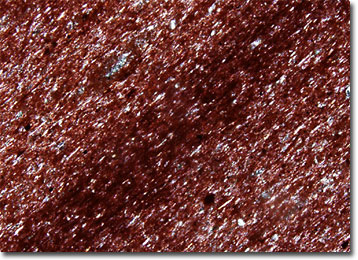Polarized Light Microscopy Digital Image Gallery
Red Slate
The word slate is derived from the Middle English and Scottish word sclate, which is related to an Old French verb meaning “to break” or “to splinter.” The etymological roots of the word are an indicative of the highly cleavable nature of the rock.

Slates are metamorphic rocks, most of which began as clay sediments deposited by water. The age of slates varies somewhat, but many were formed among old deposits of rock found deep beneath the surface of the Earth. Slate appears in a wide range of colors and greatly depends upon the mineral composition of the rock. Red slate, for instance, gains its hue from the significant amount of hematite, a crystalline form of ferric oxide, it contains. Green slates, on the other hand, often are comprised of sizable amounts of the green clay mineral chlorite, and dark slates often owe their color to carbonaceous material or fine particles of iron sulfide.
Useful for a wide variety of purposes, slate is an economically significant rock. The material, which splits readily along cleavage planes, is most often utilized for laboratory countertops, roofing, flooring, and blackboards. In crushed form, it is also often used as filler and as a component of aggregates. In earlier times, slate gained use as a writing instrument and as a means for generating turkey calls, an unusual practice that was first utilized centuries ago.
